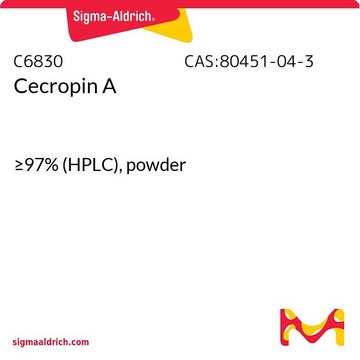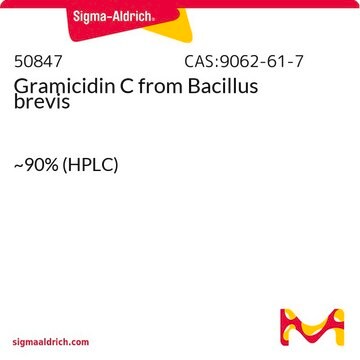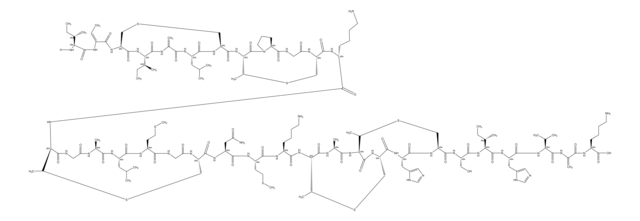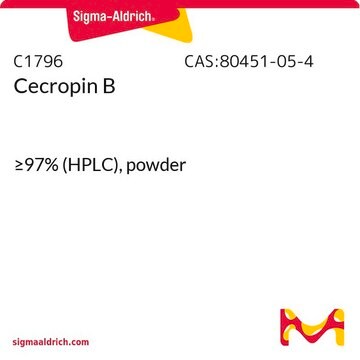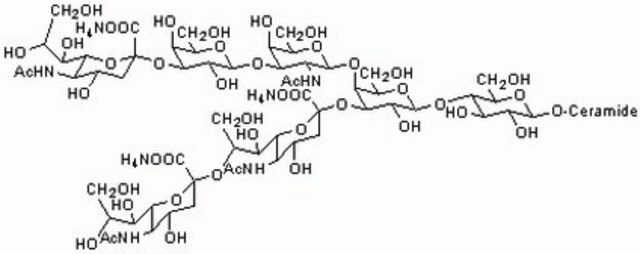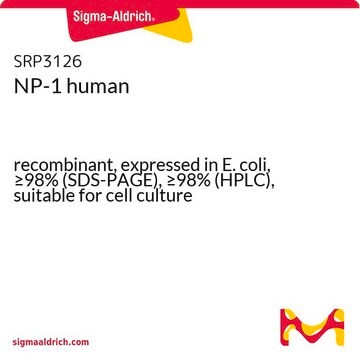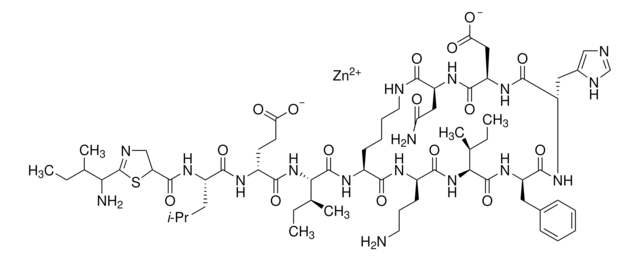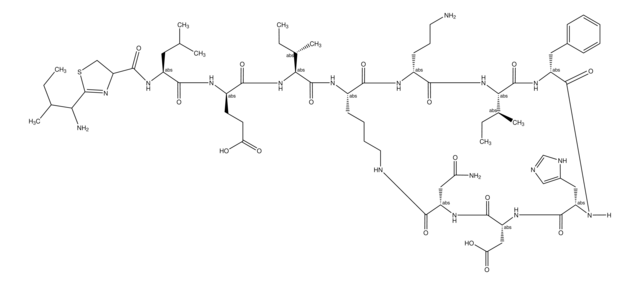B2809
Bactenecin
≥95% (HPLC)
About This Item
Prodotti consigliati
Livello qualitativo
Saggio
≥95% (HPLC)
Forma fisica
powder
Solubilità
1 mg/mL (in 1% TFA in H20)
Spettro attività antibiotica
Gram-negative bacteria
Modalità d’azione
cell membrane | interferes
Temperatura di conservazione
−20°C
Stringa SMILE
CC[C@H](C)[C@@H]1NC(=O)[C@H](CCCNC(N)=N)NC(=O)[C@H](CSSC[C@H](NC(=O)[C@@H](NC(=O)[C@H](CCCNC(N)=N)NC(=O)[C@@H](NC(=O)[C@@H](NC(=O)[C@@H](NC1=O)C(C)C)C(C)C)[C@@H](C)CC)C(C)C)C(=O)N[C@@H](CCCNC(N)=N)C(O)=O)NC(=O)[C@H](CC(C)C)NC(=O)[C@@H](N)CCCNC(N)=N
InChI
1S/C63H118N24O13S2/c1-13-34(11)46-57(97)78-38(21-17-25-75-62(69)70)49(89)83-43(31(5)6)54(94)82-42(53(93)79-39(59(99)100)22-18-26-76-63(71)72)29-102-101-28-41(81-51(91)40(27-30(3)4)80-48(88)36(64)19-15-23-73-60(65)66)52(92)77-37(20-16-24-74-61(67)68)50(90)86-47(35(12)14-2)58(98)85-44(32(7)8)55(95)84-45(33(9)10)56(96)87-46/h30-47H,13-29,64H2,1-12H3,(H,77,92)(H,78,97)(H,79,93)(H,80,88)(H,81,91)(H,82,94)(H,83,89)(H,84,95)(H,85,98)(H,86,90)(H,87,96)(H,99,100)(H4,65,66,73)(H4,67,68,74)(H4,69,70,75)(H4,71,72,76)/t34-,35-,36-,37-,38-,39-,40-,41-,42-,43-,44-,45-,46-,47-/m0/s1
RHISNKCGUDDGEG-CJMCYECYSA-N
Amino Acid Sequence
Descrizione generale
Applicazioni
Azioni biochim/fisiol
Altre note
Codice della classe di stoccaggio
11 - Combustible Solids
Classe di pericolosità dell'acqua (WGK)
WGK 3
Punto d’infiammabilità (°F)
Not applicable
Punto d’infiammabilità (°C)
Not applicable
Dispositivi di protezione individuale
Eyeshields, Gloves, type N95 (US)
Certificati d'analisi (COA)
Cerca il Certificati d'analisi (COA) digitando il numero di lotto/batch corrispondente. I numeri di lotto o di batch sono stampati sull'etichetta dei prodotti dopo la parola ‘Lotto’ o ‘Batch’.
Possiedi già questo prodotto?
I documenti relativi ai prodotti acquistati recentemente sono disponibili nell’Archivio dei documenti.
I clienti hanno visto anche
Il team dei nostri ricercatori vanta grande esperienza in tutte le aree della ricerca quali Life Science, scienza dei materiali, sintesi chimica, cromatografia, discipline analitiche, ecc..
Contatta l'Assistenza Tecnica.